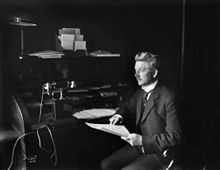Magnus Nilssen

Magnus Nilssen (18 July 1871 – 20 November 1947) was Norwegian politician for the Labour and Social Democratic Labour parties.
He was born in Lillehammer as a son of shoemaker Mathias Nilssen (1834–1920) and his wife Eline Pedersen (1835–1918).[1] He was a first cousin of Marcus Halfdan Kastrud.[2] He finished his appreniceship as a goldsmith in 1889, and moved to Kristiania in the same year. He was a secretary in his local trade union from 1891 to 1892 and treasruer in 1893. He was also member of the socialist youth club Friheden in both Kristiania and Sarpsborg (where he lived in 1894). He started his own goldsmith business in 1897. In November the same year he married Inga Marie Ravneberg.[1]
He joined the Norwegian Labour Party, and became a member of the central board in 1900. From 1901 to 1918 he was the party secretary. He lost out when "the new direction" became dominant in 1918.[1] "The new direction" had tried to replace him with Alfred Madsen at the national convention in 1915.[3] In 1921 he quit the central board to co-found a new party, the Social Democratic Labour Party of Norway. He chaired this party throughout its existence, from 1921 to 1927.[1] He took part at the founding congress of the Labour and Socialist International in 1923; the other Norwegian delegates were Arne Magnussen, Michael Puntervold and Olav Kringen.[4]
Nilssen was a member of Kristiania (Oslo) city council from 1902 to 1910, 1914 to 1919 and 1926 to 1928.[1] To the Parliament of Norway he was elected for the first time in the Norwegian parliamentary election, 1906. He represented his city. He was re-elected eight times, to serve a total of nine terms in Parliament. There was a hiatus between 1922 and 1927; he was never elected to Parliament for the Social Democratic Labour Party.[2] He served as President of the Lagting from 1919 to 1921 and Vice President of the Storting from 1935 to 1945. After the reunion of Labour and Social Democratic Labour in 1927, he rejoined the Labour Party central board, this time as deputy party leader.[1] The party had two deputy leaders—Nilssen and Edvard Bull, Sr.—to accommodate different wings within the party.[5] Nilssen also served as Minister of Labour in the two-week Hornsrud's Cabinet between January and February 1928.[1]
He left as deputy leader in 1939, and left the central board in 1945. His last term in Parliament ended in 1945—de facto with a hiatus from 1940 to 1945, when Germany occupied Norway and suspended Parliament. Nilssen participated in the Riksråd negotiations in 1940 between Germans and those parliamentarians who had not fled the country, in which the Presidium infamously asked King Haakon VII to abdicate.[1] During the remainder of the occupation, Nilssen lost all his public positions.[2] After the occupation and war, he was dropped by the Labour Party as their member of the Presidium, and was not summoned to the relevant meetings and forums.[6] Fredrik Monsen was the party's new member of the Presidium.[7]
Nilssen was a member of the supervisory committee of the Gjøvik Line from 1908 to 1919, and of the supervisory council of Norges Brannkasse. He was a school board member in Oslo from 1910 to 1922 and 1929 to 1937, and a board member of Norges Statsbaner from 1922 and Oslo Hospital from 1933. He was a deputy board member of the Institute for Comparative Research in Human Culture from 1938 to 1940, and a deputy member of the Norwegian Nobel Committee from 1922 to 1940.[2]
Nilssen died in November 1947 in Oslo.[1]
References
- ↑ 1.0 1.1 1.2 1.3 1.4 1.5 1.6 1.7 1.8 Terjesen, Einar A. "Magnus Nilssen". In Helle, Knut. Norsk biografisk leksikon (in Norwegian). Oslo: Kunnskapsforlaget. Retrieved 3 September 2010.
- ↑ 2.0 2.1 2.2 2.3 "Magnus Nilssen" (in Norwegian). Norwegian Social Science Data Services (NSD). Retrieved 3 September 2010.
- ↑ Bjørgum, Jorunn (1998). Martin Tranmæl og radikaliseringen av norsk arbeiderbevegelse 1906-1918 (in Norwegian). Oslo: Universitetsforlaget. p. 213. ISBN 82-00-12863-6.
- ↑ Maurseth, Per (1987). Gjennom kriser til makt 1920-1935. Volume three of Arbeiderbevegelsens historie i Norge (in Norwegian). Oslo: Tiden. p. 31. ISBN 82-10-02753-0.
- ↑ Maurseth, 1987: pp. 431–432
- ↑ Berntsen, Harald (2006). Statsministerkuppet (in Norwegian). Oslo: Centrum. pp. 39, 53, 69. ISBN 978-82-307-0002-0.
- ↑ Berntsen, 2006: p. 104
| Party political offices | ||
|---|---|---|
| Preceded by Olav Kringen |
Party secretary of the Labour Party 1901–1918 |
Succeeded by Martin Tranmæl |
| Preceded by position created |
Chairman of the Social Democratic Labour Party 1921–1927 |
Succeeded by position abolished |
| Political offices | ||
| Preceded by Worm Hirsch Darre-Jenssen |
Minister of Labour January 1928–February 1928 |
Succeeded by Ole Monsen Mjelde |
| |||||||||||||||||||
|